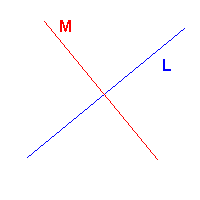


|  |
The Algebraic Inversion Theorem
|
We use complex numbers as "coordinates" in E. The point A(a,b) is described by the complex number a =a + ib.
Then the locus Ak(A,B) = {P : PA = k.PB}
has equation
|z -a| = k.|z - b|, For typographical reasons, we will use z* to denote the complex conjugate of z.
Immediately we see that inversion in the i-line given by the real axis is |
We shall simply say that A is the point a |
|
Inversion in the i-line |z| = r is also easy to describe,
|
|
|
We are now in a position to give a neat proof that inversion maps i-lines
The Algebraic Inversion Theorem
Suppose that L and C are i-lines, and that iC denotes inversion with respect to C.
Proof of The Algebraic Inversion Theorem
|
|
| We can now prove a result fundamental to the creation of hyperbolic geometry.
Observe that, if L and M are lines, then iL is just reflection in L.
In fact, this is true for any i-lines. As you may guess, the proof amounts
The Mirror Property
Suppose that L and M are distinct i-lines, then
|
 |
In fact, when , L and M are orthogonal, more is true.
If L and M are orthogonal i-lines, then iL(Mº) = Mº,
In the CabriJava pane on the right, S is a point on the arc of L lying inside M. You can experiment by dragging S or A.
|
|
| We can think of this as saying that the two regions of the disc Mº are "reflections" of one another in a circular "mirror" L. |
This is not optically sound, but it is a good analogy. |
| Main inversive page |